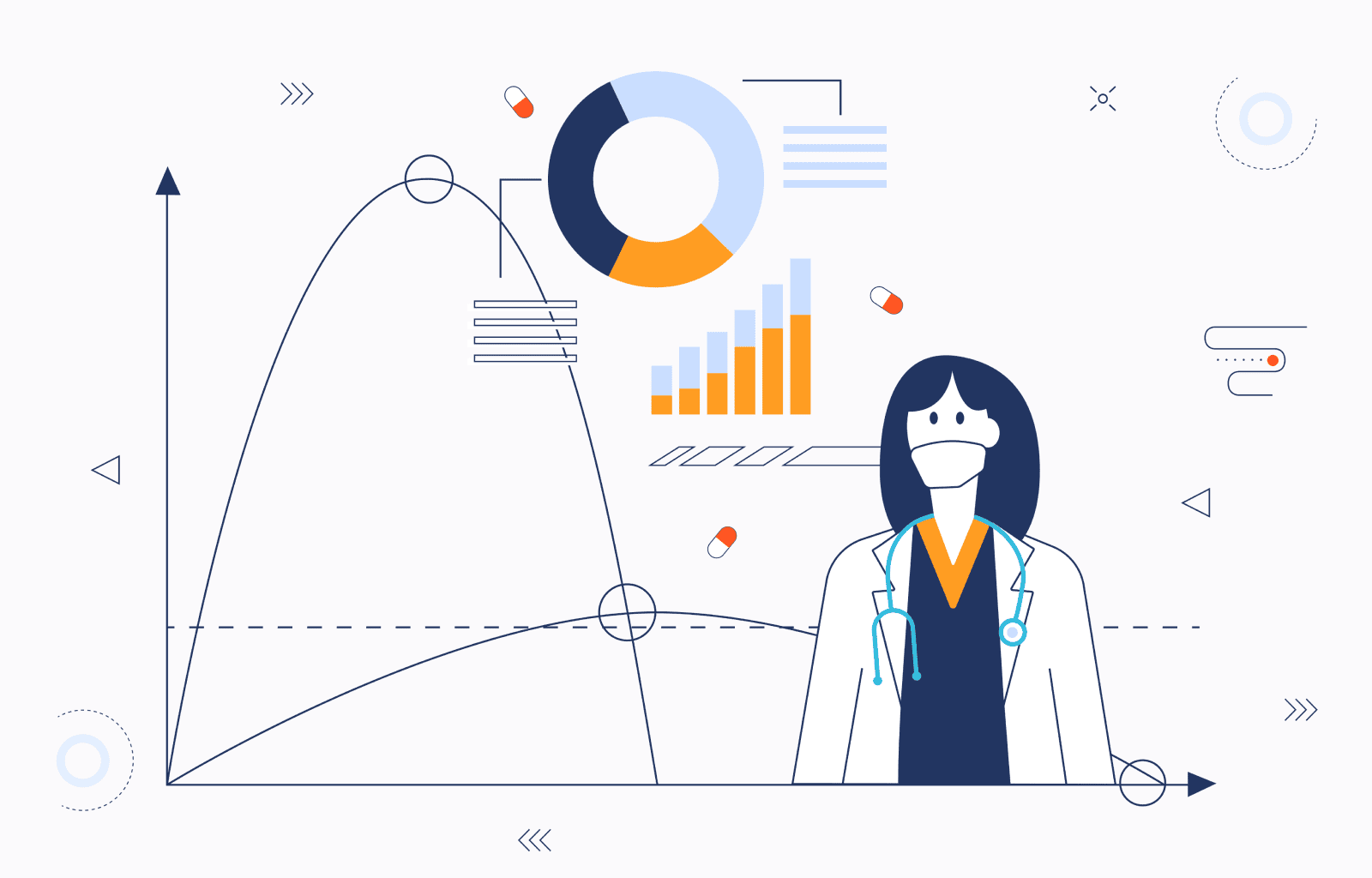Predictive Analytics in Healthcare: Top Use Cases

It’s hard to predict the future. In fact, a lot of people would say it’s impossible. That may be true, but healthcare predictive analytics can certainly come close. This technology aims to forecast future events, thereby improving patient care and making facilities more efficient.
Healthcare institutions and organizations have long-kept considerable data and statistics. However, due to the large volume of data, it was difficult and time consuming to accurately organize and review. Thanks to modern machine learning and artificial intelligence (AI), this data can now be quickly and effectively analyzed to provide accurate real-time insights.
This data can even be used to make accurate predictions about the future, which has significant implications for patient care.
It can be used to make clinical decisions, predict trends, and much more. The effective use of predictive analytics in healthcare opens significant opportunities and provides serious benefits that can streamline healthcare, improve patient outcomes, provide better treatment, reduce costs, and help manage diseases and other medical issues.
What is Predictive Analytics in Healthcare?
At its most basic, predictive analytics is the process of using data to answer questions about what may happen in the future. This process uses historical data to identify trends and forecast future situations. These predictions can be short-term or long-term.
In the past, predictive analysis needed to be completed manually and legacy healthcare systems could not provide much assistance. People would look at trends, statistics, and data and then use this information to make assumptions about what may occur in the future. Today, thanks to technological advancements such as machine learning, these predictions can be made much more quickly and with greater accuracy today.
The usage of predictive analytics in healthcare has many benefits. By using patient data (such as medical records and treatment results), health surveys, clinical data, disease and patient registries, and other healthcare data, clinics and healthcare providers can make more effective clinical and operational decisions.
Top Use Cases of Predictive Analytics in Healthcare
There are many significant ways to use predictive analytics in healthcare. These applications can be beneficial to patients, healthcare facilities, equipment manufacturers, and the industry as a whole.
Early Disease Detection and Diagnosis
One of the most powerful uses of predictive models in healthcare is detecting the early signs of diseases. There are many diseases and health conditions that are significantly more treatable if identified early. However, unfortunately many of these conditions are difficult to detect and identify.
Usually, a healthcare provider doesn’t know that a person has a specific condition until significant symptoms arise. In some cases, waiting this long to administer treatment significantly reduces the chances of a positive outcome.
Using healthcare predictive analytics, AI algorithms can analyze large datasets to identify individuals who are at risk of developing certain conditions or diseases. This lets them receive medical intervention and potential treatment earlier, improving patient outcomes.
Personalized Treatment Plans
In addition to helping people identify and detect diseases, predictive analytics is also used to provide personalized treatment plans. By comparing patient data to medical knowledge databases, a personalized plan can be created.
Healthcare providers are then better able to tailor treatments to a patient’s medical history and genetic makeup, which reduces the likelihood of adverse effects and maximizes the effectiveness of treatments.
Personalized treatment plans are more effective than a one-size-fits-all approach. However, traditionally medication and other treatment has been based on a broad population and overall statistics, and not the unique aspects of a specific patient.
Just because a treatment works most of the time for a large number of people, it doesn’t mean that it’s the right option in every situation. Predictive analytics takes a large dataset and uses it to determine the best course of action for a specific individual, improving outcomes and providing overall better support and care.
Resource Allocation and Management
In addition to improving patient outcomes, predictive analytics can be used to optimize resource allocation. For instance, a hospital can analyze historical trends to help them determine the predicted number of admissions at a certain time. This makes it easier to properly ensure correct resource levels, such as beds, staff, equipment, and medical supplies.
This has a significant impact on operational efficiency. Rather than having to count on vague trends such as “this hospital is usually busier on Saturdays” or “we admit more patients in the summer than in the fall”, you can have real answers based on historical data for your area and for your specific institution. This is especially helpful because it helps hospitals and other facilities prepare for peak periods and provide better care during these times.
Predictive Maintenance of Medical Equipment
Medical equipment often needs maintenance, but it has traditionally been tough to know exactly when. In the past, healthcare facilities would have to count on generalized timelines (such as knowing that certain equipment has an average lifespan of five years, for instance) or wait until there was a problem before getting a repair.
This was not only inefficient, but also reduce the quality of care. If equipment failed before you expected it to, you could be left without critical medical devices. If it was sent for repair when it didn’t need it, this wasted time and money.
Through predictive analysis, you can schedule maintenance in advance and do so when the equipment needs the work and when it isn’t being used (which can also be determined through predictive analysis). This not only reduces downtime, but it saves money as well. In the vast majority of cases, doing maintenance before a problem arises is significantly more cost effective than waiting until something goes wrong.
Hospital Operations Optimization
Some of the biggest problems the healthcare industry has are increasing costs and long wait times for care. No one wants to make patients wait for important medical treatments, but when resources are stretched and providing care takes considerable time, increasing wait times is something that many facilities need to do.
Of course, these same institutions also need to control costs.
Predictive analytics can help hospitals achieve both goals by improving operational efficiency.
For instance, by looking at historical data, hospitals can accurately estimate bed occupancy rates to use resources more efficiently. This may involve scheduling elective procedures or less timely treatments for times when there will be more capacity in the hospital. Doing so allows the institution to provide better care and reduce the ups and downs that lead to excessively busy periods followed by slow periods. Using data to make such predictions not only better allocates space and resources, but it also helps reduce burnout as work becomes more consistent.
Machine learning and predictive analytics can also help better predict surgery durations and patient discharge times, further helping to make a hospital more efficient, improve scheduling, and reduce costs.
Medication Adherence
Another incredibly effective way to use predictive analytics is to improve patient adherence. Patients not taking their medications as prescribed is a significant issue that has significant consequences, especially for those who have chronic disease.
There are many reasons for medication nonadherence. They range from fear, mistrust, and misunderstandings to concerns about cost. Some patients erroneously believe that they should stop taking medications if they aren’t experiencing symptoms while others are simply taking what they believe to be too many medications, so they start cutting them down (either on purpose or due to confusion).
Traditionally, recognizing nonadherent patients required asking them questions and trusting them to provide accurate answers, or perhaps reviewing pharmacy claims data. Both methods are unreliable, costly, and time consuming.
A 2019 study estimated that “that 50 percent of patients with chronic diseases do not take their medications as prescribed” and that this “leads to potentially avoidable morbidity and mortality, as well as unnecessary health care use and costs.”
It goes on to conclude that “Predictive analytics may be a more sustainable, proactive approach for identifying patients at risk of medication nonadherence”
Another study, this one from 2020, found that “an accurate and sensitive adherence prediction model… may provide a technical tool for individualized diabetes care.”
This shows the specific benefits of using predictive analytics to improve care. Not only does it individualize care, which is important for both efficacy and patient adherence, but it also gives healthcare provides sustainable and proactive tools they can use to improve their jobs while increasing the level of care.
Benefits of Predictive Analytics in Healthcare
As shown, there are many significant benefits of predictive analytics in healthcare. Providing accurate, timely, and efficient treatment is a critical aspect of the healthcare industry.
Predictive analytics allows institutions to use resources more effectively, decreasing costs and increasing efficiency. It also helps improve the level of care, since the data can help reduce the risk of complications or side effects, lead to early detection of illnesses and diseases, and personalize care to better treat individuals.
The use of predictive analytics also frees up time for practitioners. Rather than having to spend valuable time manually analyzing data, they can instead focus on patient care. This not only improves the level of care, but it also increases morale among healthcare workers and reduces potential burnout.
Not only does predictive analytics help provide better care and save costs, but it can also increase trust in the healthcare system. Often patients are hesitant to accept care or trust medical practitioners. They may feel like their treatments are based on “medical opinions” rather than facts, or they believe that healthcare providers are “treating them like a number” and not individualizing their care.
Predictive analytics increase trust in medical treatments. Patients receive care that is tailored to their specific needs, with fewer inherent biases affecting the decision making. Having data to back their decisions also improves practitioner confidence.
Future Potential of Predictive Analytics in Healthcare
Machine learning, predictive analytics, and artificial intelligence are changing the world in many ways. This includes healthcare. However, for these tools to be the transformative drivers of change that they can be, they need to be used effectively.
This means collecting high quality data, using the right analysis methods and predictive analytic models, and being able to properly explain these methods to all stakeholders. When dealing with healthcare data, it’s also crucial to always use proper care and security to protect sensitive medical information. Failing to do this not only exposes this personal data, but it also undermines trust in the process.
If handled correctly, predictive analytics could significantly change the healthcare industry for the better. It will give physicians and researchers more time to work with patients and conduct research while streamlining operations, reducing costs, and improving the overall level of care.
Contact us

